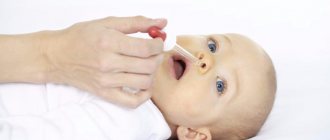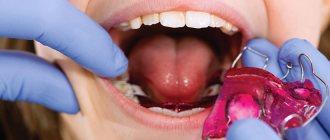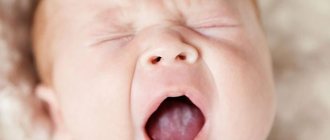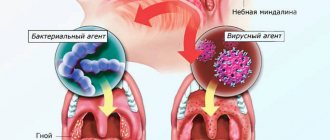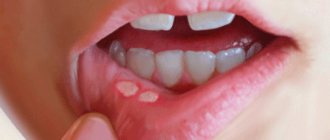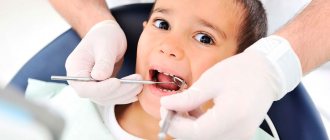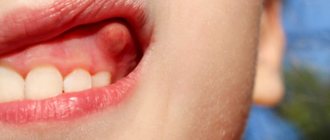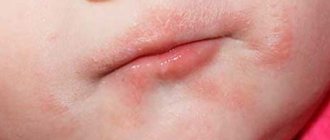- Why is there so much saliva?
- Saliva and its functions
- How to help your baby
- Baby care
- If the abundance of saliva scares you
Just yesterday your little one was a cute baby, but today he suddenly started blowing bubbles.
What happened, why is your mouth watering so much that you don’t have time to wipe it off? What should I do: call a doctor or is it not dangerous and will they go away on their own? With the birth of a child, a mother has new questions every day. Before, there were no tears when I cried. Then you need to wipe your mouth, clean your ears, but it’s scary to get hurt. Now suddenly my mouth started watering, and for some reason so much. There are many questions, let's consult a pediatrician.
Why is there so much saliva?
Your newborn is growing, becoming large, and reaching two to three months of age. At this stage of development, the salivary glands form and begin to work. Therefore, excessive drooling is normal.
During this same period, the baby becomes more active. The child explores and tastes everything that surrounds him. Therefore, the body produces a protective antibacterial environment - saliva, which washes away dirt that gets into the small mouth.
The newborn has already drooled, but the baby still does not know how to swallow it, so streams flow down his chin. Parents are frightened by such profuse drooling. If the saliva is clear, not foamy, not thick, not stringy, experienced mothers do not worry. Mothers know that this is a normal state for a baby at this age.
Saliva and its functions
Saliva is necessary for the body at any age. In the oral cavity, under the tongue, on the inside of the cheeks, behind the lower teeth, there are salivary glands. They work constantly, producing up to two liters of fluid per day for an adult.
Saliva takes care of maintaining pH in the desired state, preventing the formation of tartar and caries. Saliva destroys harmful microorganisms, thereby preventing unpleasant odor in the mouth.
Saliva is involved in processing and digesting food. Salivary enzymes help break down and digest substances and produce glucose from starch.
This liquid softens and liquefies food for better digestion. Without saliva, taste buds do not work.
In newborn babies, saliva performs many tasks related to digestion and protection. Protective functions of saliva in a baby’s life:
- Protection of the oral cavity from the colonization and proliferation of pathogenic microbes and bacteria.
- Protection and lubrication of mucous membranes from irritation and damage.
- Protecting mucous membranes from dehydration and drying out during swallowing, chewing, and talking.
- Cleaning the oral cavity from foreign bacteria and food debris.
In addition to protective functions, saliva performs a number of other tasks. It plays a great role in matters of nutrition and the functioning of the gastrointestinal tract. The enzymes it contains are responsible for the initial processing of starch. And tongue lipase helps infants digest milk. It is saliva that forms the sense of taste by helping taste buds dissolve solids in food.
In the future, the gums will swell, become inflamed, the teeth will feel, saliva will soften the pain and protect the wounds from infection. And when the teeth erupt, saliva will maintain the integrity of the tooth enamel by treating it with calcium, phosphate, and fluoride dissolved in it.
How to help your baby
Parents will have to come to terms with and go through the period of slobbering toddler. It is unpleasant for the baby to be slobbery, so parents take special care and care for the baby at this time.
It’s not in vain, apparently, that our great-grandmothers invented bibs for babies. Bibs will help now: the fabric absorbs liquid, blouses remain dry, the skin on the neck and chest is also dry.
Sometimes a baby drools so much when lying down that he chokes and simply choke on it. He may experience a cough, even wheezing. To prevent your child from getting into trouble, place him on his side or tummy, or you can put him on a low pillow. So, the drool will flow down and will not harm the baby.
If a baby sucks on a pacifier, he is able to swallow his saliva. When going for a walk, give your baby a pacifier. Using a pacifier is another way to cope with the problem.
Soon the time for teething comes, the baby's gums itch and itch, he constantly chews something to relieve the itching. Help him, massage his gums with your finger. And in the places where the first teeth appear, press lightly. On the doctor's recommendation, buy a special product and lightly lubricate the gums with it, this will calm the baby.
How to help with a cough in a baby without fever
If a child coughs frequently and this prevents him from breathing and eating, the help of a pediatrician is needed. In case of rare attacks, it is necessary to try to find the cause of the cough reflex from the above and provide assistance to the baby:
- take the baby in your arms and calm him down;
- free his chest from tight clothing;
- give the child warm water;
- provide access to fresh air in the room, take a walk with your child outside;
- If there is a large amount of mucus and crusts in the child’s nose, they must be carefully removed with a soft cloth and an aspirator.
A nursing mother should reconsider her diet, try to do wet cleaning in the baby’s room more often, not turn on the batteries at full power during the cold season, and use a humidifier.
If your baby gets sick with ARVI, it is necessary to start antiviral therapy.
Baby care
Excessive salivation requires increased care from parents. Mothers stock up on handkerchiefs or soft napkins to wipe the newborn's mouth and chin.
Even with constant wetting of the chin, dripping drool causes redness, peeling, and a rash on the skin around the mouth and on the chin. Knowledgeable mothers advise using baby cream and lubricating irritated areas several times a day until the skin is restored.
Your doctor will tell you which creams and ointments to relieve irritation on your child’s skin. You need to lubricate delicate skin with the prescribed products very carefully, in a thin layer, so as not to cause even more irritation.
What to do if your baby is coughing from colds and flu
One of the drugs that can be used to treat very young children, including newborns and premature babies with a gestational age of less than 34 weeks, is the antiviral drug VIFERON.
The drug VIFERON has a wide spectrum of antiviral activity. Alpha-2b interferon, which is part of the drug, was created on the basis of modern technologies. Antiviral properties allow it to block the reproduction of the virus, and the immunomodulatory effect helps restore immunity. The drug was developed as a result of fundamental research in the field of immunology, which proved that in the presence of antioxidants (vitamins C, E and others), the antiviral effect of interferon is enhanced.
For the treatment of children under one year old, the drug VIFERON is used in the form of suppositories and gel. The ointment is used to treat children over 1 year of age.
Children under 7 years old, incl. newborns and premature infants with a gestational age of more than 34 weeks are prescribed VIFERON Suppositories (suppositories) 150,000 IU, 1 suppository 2 times a day after 12 hours every day for 5 days. According to clinical indications, therapy can be continued. The break between courses is 5 days.
Premature newborns with a gestational age of less than 34 weeks are recommended to use the drug VIFERON 150,000 IU, 1 suppository 3 times a day after 8 hours every day for 5 days.
The article “Acute respiratory infections in children: optimization of treatment tactics” describes the results of a study of the use of the drug VIFERON in the treatment of ARVI and influenza.1 In the group consisting of children of different ages who received the drug, positive dynamics were observed: body temperature tended to normal, symptoms decreased intoxication, the intensity decreased until the cessation of catarrhal symptoms (cough, runny nose) and respiratory syndrome (difficulty breathing) on average two days earlier than in the control group. For children undergoing treatment in a hospital, nosocomial infection becomes a frequent problem and threat to delay treatment and complications of the underlying disease. It is important that among children who received VIFERON, infection occurred half as often.
Depending on the pediatrician’s recommendations, for the treatment of ARVI, it is necessary to apply a strip of VIFERON Gel approximately 0.5 cm long to the nasal mucosa 3-5 times a day for 5 days. Before this, it is better to rinse the mucous membrane with saline solution. In order to protect a child from ARVI, it is necessary to apply a strip of gel approximately 0.5 cm long to the nasal mucosa 2 times a day as a preventive measure. Course duration is 2-4 weeks.
Reference and information material
Author of the article
Gerasimenko Igor Olegovich
General doctor
Sources:
- Nikolaeva S.V., Khlypovka Yu.N., Gorelov A.V. Acute respiratory infections in children: optimization of treatment tactics. //RMJ 2019; 1(*): pp.1-5.
i https://cyberleninka.ru/
ii https://www.rmj.ru/
Loading...
Take other surveys
If the abundance of saliva scares you
Usually, a 2-3 month old baby begins to produce copious amounts of saliva as the salivary glands begin to function. The second stage, which decorates the little one with bubbles, is the period of teething.
During colds and other diseases of the ENT organs, with allergic reactions to house dust or animals, when the nose does not breathe, the baby has to open his mouth. In such cases, the amount of saliva that can drain from the mouth increases. Consult a doctor, eliminate the cause, and the amount of saliva will return to normal.
The causes of excessive leakage may be gastrointestinal diseases. And also if the baby does not know how to close his mouth tightly. It must be said that when affected by an oral disease such as thrush, saliva partially loses its functions. In particular, the digestion of starch into glucose stops. The absence or insufficiency of sugars in the body of infants will negatively affect their development. Therefore, during your daily morning toilet, look into your baby’s mouth, and if you have any suspicions, contact your pediatrician.
But if there is too much saliva, it is of a different color, type or consistency, if the abundance of discharge scares you, be sure to consult a pediatrician. If necessary, after a thorough examination and tests, the pediatrician will refer you to another specialist. An ENT specialist, a neurologist, a dentist, and a surgeon can help.
Using saliva analysis, the doctor will make the correct diagnosis. If the baby has problems of an endocrine nature or in the adrenal cortex, a saliva test will show the disease. To obtain accurate data, saliva is tested several times during the day. It is not difficult, painless, and will show the right result.
If the baby is healthy, the period of drooling will soon stop, the baby's mouth and chin will be dry.
When a baby begins to put not only his fists into his mouth, but also all objects that he is able to reach, the first thought of the parents is that teeth are coming out. The eruption of baby teeth in young children is often accompanied by increased salivation. This is not the only reason for the occurrence of such symptoms, however, due to the prevailing stereotype, most mothers of children in their first year of life do not try to understand why the baby’s gums are itchy and eliminate the source of severe discomfort.
More details about the problem
Abdominal pain is one of the most common childhood complaints, and fortunately, it is mostly temporary and harmless. Possible causes are varied and range from infections and food intolerances to functional discomfort.
Among the main provoking factors:
- digestive problems;
- intestinal infection;
- lack of bowel movement for several days;
- too fatty or sweet foods, as well as spoiled foods.
Mental problems, fears and stress also manifest as discomfort. It is usually harmless and will go away when the cause is eliminated. In addition, the body's reaction to excitement, anxiety or joyful excitement can also cause this symptom. Most often, the problem disappears quickly and does not require medical intervention.
Drooling and chewing of fists during teething
It is teething that most often provokes the appearance of itching and painful sensations in the oral cavity in infants. At the same time, the child is drooling in bubbles, he constantly holds his fists in his mouth. As a rule, this process begins at the beginning of the 6th month of life, but often the first symptoms appear at 2-3 months of age, and sometimes earlier. The advancement of the first molars in the gums may be accompanied by an increase in body temperature, disturbances in the gastrointestinal tract, and increased excitability. However, the main sign of the appearance of teeth is swelling and swelling of the baby’s soft gum tissue.
Cause: oral diseases (stomatitis, thrush)
If the baby constantly sucks his fists, and increased salivation is accompanied by an increase in body temperature, a white coating is clearly visible on the tongue, gums and mucous membranes, you should immediately consult a doctor. These symptoms indicate damage to the oral cavity by a fungus of the genus Candida. Factors contributing to the appearance of thrush in children:
- Sugar consumption. The baby can receive it both from baby food (manufacturers often use artificial sweeteners to improve taste) and from breast milk (if the mother’s diet contains refined foods, sweets and preservatives in large quantities).
- Decreased immunity. Thrush in infants often accompanies infectious diseases.
- Poor hygiene. Pathogenic fungi enter the body of a two to three month old baby with dirty nipples and toys, as well as if he puts dirty fingers or fists in his mouth.
- Taking antibiotics. They destroy bacteria that prevent the growth and reproduction of pathogens.
Often children at 2-4 months drool continuously due to stomatitis. With this pathology, blisters and ulcers appear on the oral mucosa. Babies may refuse to eat due to severe pain.
Nature and areas of localization
In infants in the first 3-4 months of life, repeated abdominal pain, which often occurs at the same time of day or night and leads to strong cries, is characteristic of the so-called “three-month colic”. Often, gentle massage or stroking will relieve discomfort. In any case, contact your pediatrician to rule out other causes.
Table - Types and characteristics of abdominal pain in a child
| View | Visceral | Somatic |
| Character | Spastic | Acute, intense, constant, progressive with movement. |
| Localization area | Spilled, unlocalized | Local (within the pathological process) |
| Duration | From a few minutes to several months | Constant |
| Irradiation | Gives to the leg, arm, shoulder blade | Appears only in cases of high intensity and corresponds to the affected organ. |
| Sensations on palpation | In the area of pain localization | In the area of the affected organ |
| Associated symptoms | Tachycardia, excessive sweating, pale skin, vomiting | Typically absent |
In children of early and middle school age, if discomfort appears, you can observe for a while. As a rule, abdominal pain is localized in the navel area, occurs only during the day and is sometimes accompanied by bloating, as well as alternating constipation and diarrhea.
You should contact your pediatrician if your child experiences the following symptoms:
- periodic pain in the same place away from the navel;
- waking up at night due to discomfort in the abdominal area;
- colicky attacks, which are accompanied by sweating;
- discomfort during urination;
- persistent or frequent diarrhea for 4 weeks;
- blood in the stool, repeated vomiting, streaks of blood or bile juice in the vomit;
- noticeable weight loss, lack of weight gain, or stunted growth;
- prolonged increase in temperature.
Possible causes with warning symptoms include intestinal diseases, such as inflammation, celiac disease (gluten intolerance), food allergies, narrowing of the intestine, kidney malformations, kidney or gallstones, inflammation of the pancreas and other rare abdominal diseases.
Many children have no organic cause for their discomfort. Rather, there is a special sensitivity to bowel movements (overexcitation or irritation of the walls).
Bloating
Occurs due to gas formation in the gastrointestinal tract. It can develop in infants because they swallow a lot of air while sucking and drinking. Babies who eat high-fiber foods and eat plenty of vegetables and fruits are more likely to experience this condition.
If a child is prone to flatulence, a lot can be done for prevention and relief:
- purchase the right bottle and special drops that reduce gas formation;
- massage around the navel clockwise;
- provide sufficient time to chew food thoroughly;
- for prevention, give infusion of fennel, anise and caraway tea;
- minimize the amount of gas-causing foods (cabbage or legumes).
Gymnastic exercises - for example, lying on your back with your legs in the air "riding a bicycle" - as well as walking in the air, help improve the condition.
Constipation pain
Characterized by rare passage and hardening of feces. The child constantly complains of discomfort during bowel movements, so he is reluctant to go to the toilet. The situation could become a real problem.
To alleviate the condition, it is recommended:
- move a lot and drink enough;
- Eat a high-fiber diet with plenty of fruits, vegetables and whole grains;
- eat soaked dried fruits, flaxseed, wheat bran and yogurt;
- take warm relaxing baths.
Epigastric pain
Discomfort in the upper abdomen may come from one of the organs located there. These include the stomach, duodenum, liver, gallbladder, spleen (left behind the stomach) and pancreas (center behind the stomach).
The causes in children of middle school and adolescence in 50-70% of cases are:
- Heartburn, reflux disease. A burning, ascending pain behind the sternum, in the upper abdomen and possibly up to the neck, as well as temporary sour belching are the leading symptoms. Most often they occur after a heavy meal. With repeated contact with aggressive stomach acid, the lining of the esophagus can become inflamed (reflux esophagitis).
- Irritation of the gastric mucosa. Discomfort is manifested by convulsive attacks that do not depend on food intake. A feeling of fullness, bloating and loss of appetite are often added.
- Inflammation of the gastric mucosa. Common signs of gastritis include a feeling of fullness, lack of appetite, nausea, vomiting, heartburn, belching and bad breath.
- Stomach ulcer. Severe discomfort in the center or left side, which occurs almost immediately after eating. Over time, the discomfort subsides (often until the next meal).
- Duodenal ulcer (duodenal ulcer). Symptoms appear on an empty stomach and occur suddenly at night or a few hours after eating in the upper middle part. The condition improves after eating.
Due to its anatomical proximity to the chest, discomfort in the upper region can also be a sign of pneumonia. Problems in the spine also sometimes cause discomfort that radiates to the stomach.
Neurological disorders
In rare cases, excessive salivation indicates neurological disorders (cerebral palsy, various abnormalities in the functioning of the central nervous system). In this case, the following are observed:
Such conditions are diagnosed by specialists in the first months of a baby’s life and require serious and long-term therapy. Excessive drooling is a secondary symptom.
Parents should regularly wipe their baby's chin, neck and chest to avoid skin irritation. If your child constantly sucks his fist or keeps his fingers in his mouth, you need to keep his hands clean. If possible, you should disinfect all objects that he may lick. The lack of necessary hygiene measures leads to the entry of pathogenic microorganisms into the body, weakened by the underlying disease. The development of an infectious process can significantly worsen the baby’s condition.
Beginning ARVI
Sometimes excessive salivation, accompanied by regular attempts by the baby to put his fingers and fists in his mouth, indicates the onset of an infectious disease such as ARVI, flu, sore throat, etc. In this case, the child has a fever, nasal congestion or mucus discharge from the sinuses. Many babies begin to sneeze and cough.
The main function of saliva is protection against pathogenic microbes and bacteria. This is what causes the increased activity of the salivary glands in babies 2-4 months of age against the background of the onset of ARVI and other inflammatory processes localized in the oral cavity.
In this case, the main help lies in the fight against the causative agent of the disease. The cleanliness of the baby’s hands, pacifiers and toys should be taken with special care during this period, as there is a high risk of harmful microorganisms being introduced into the baby’s body.
Increased salivation (hypersalivation) in children: a problem for doctors and parents.
I was recently asked a question about increased drooling in a child aged 2.5 years: “Drooling constantly, not only when he starts playing or thinking and opens his mouth, but in general always when you tell him and remind him that he needs to swallow drool - swallows, understands this and swallows food normally for a very long time.”This pressing question is very difficult to comment on, but I will still try to answer it.
Hypersalivation, synonyms: ptyalism, sialorrhea, drooling
- This is an increase in the secretory activity of the salivary glands. In children aged the first two years of life, this phenomenon is considered physiological during the eruption of the first (baby) teeth.
In older children, hypersalivation is regarded as a disease that brings a lot of trouble, anxiety and discomfort to the child and parents.
In such children, first of all, a disturbed swallowing reflex is observed, and not a true increased production of saliva, which is commonly called hypersalivation, which is noted in the following pathological conditions:
- stomatitis (pathology of the oral mucosa);
- viral diseases affecting the salivary glands (viral sialadenitis);
- diseases of the gastrointestinal tract (pancreatitis, peptic ulcer, etc.)
- helminthic infestation;
- diseases of the central nervous system (cerebral palsy (cerebral palsy), bulbar palsy, Parkinson's disease, encephalitis of various natures (etiologies); lateral myographic sclerosis, brain tumors, strokes, some forms of schizophrenia, etc.);
- nervous stress, strong psychological and emotional experiences (positive, for example, from anticipation of something tasty, or, conversely, negative);
- poisoning with lead, mercury, barbiturates, organophosphorus substances (karbofos, chlorophos, etc.).
Clinical manifestations
are expressed in a complaint about the abundance of saliva in the oral cavity and the need to constantly spit it out.
A functional study of the salivary glands (sublingual, parotid glands) with true hypersalivation reveals an increase in the amount of secretion (saliva) above the norm of more than 10 ml in 20 minutes (normally within 1-4 ml). No other pathology of the salivary glands is determined.
“Relative” or false hypersalivation occurs against the background of a violation of the act of swallowing (with an inflammatory process in the oral cavity, injury to the tongue, neurological pathology - bulbar palsy, etc.). In these cases, the amount of saliva produced corresponds to the above standards, but the patient and parents have a false feeling of its excess.
Treatment
consists of adequate treatment of the underlying disease that caused hypersalivation.
Irritation of the mucous membrane during acute inflammatory processes occurring on the oral mucosa is accompanied by an unconditional reflex increase in saliva secretion, which is a protective reaction of the body. In such cases, hypersalivation does not require treatment.
In the treatment of true hypersalivation, drugs with an anticholinergic effect are used (m-anticholinergics - atropine, antispasmodic, typhen, aprofen, diprofen, metacin, etc.). They reduce saliva production but have other serious side effects.
M-anticholinergics include belladonna alkaloids (atropine, scopolamine) and platyphylline; synthetic drugs similar in structure (for example, homatropine) and some other tertiary and quaternary ammonium compounds (aprofen, metacin, etc.). By blocking m-cholinergic receptors in organs, these drugs cause dilation of the pupils, paralysis of accommodation, increased intraocular pressure, inhibit the secretion of saliva, sweat and secretion of the glands of the stomach and intestines, increase the rhythm of heart contractions, and relax the smooth muscles of the bronchi and stomach.
Surgical treatment and radiation are also used, but these methods threaten serious complications: facial asymmetry, caries, etc.
Treatment methods such as biofeedback therapy (biofeedback) and exercises for the muscles in this area are not effective enough to cope with the problem of ptyalism.
In children, increased salivation can cause a violation of the pronunciation side of speech - the so-called dysarthria, when a large amount of saliva prevents children from mastering and pronouncing words. This can lead to the formation of slurred speech, which will further complicate the child’s development and socialization. Therefore, this problem must be solved together with a qualified speech therapist to conduct speech therapy massage.
So, in each specific case, it is necessary to ask yourself the question: “What is the cause of increased drooling?”
P. _ S. _
From the physiology of salivation and salivation it is known that when the oral mucosa is filled with saliva, peripheral receptors transmit this information along sensory nerve fibers to the brain, and from the brain along the motor (descending) pathways the command to swallow saliva is transmitted.
Now let’s remember our feelings after visiting the dentist, who gave us light pain relief (anesthesia). It seems that if you lose sensitivity in your lips, you will begin to drool. To avoid hypersalivation, the patient has to monitor the swallowing of saliva. This effect occurs because the reflex sensorimotor arc is temporarily blocked by anesthesia, and information from the oral cavity does not enter the brain.
Drooling in children with various of the above pathologies is caused by various factors. However, they all lead to disturbances at the level of the sensorimotor arc, i.e. associated with sensory disturbances. This is the main cause of drooling.
Thus, children suffer from reduced sensation (hypoesthesia), but not anesthesia (complete loss of sensation), and therefore there are significantly fewer spontaneous swallows during the day. This explains the increased salivation.
In the presence of such hypersalivation, rehabilitation should be aimed not at regularly reminding the child of the need to voluntarily swallow saliva (especially since this cannot be done constantly), but at correcting the sensorimotor arc.
To do this, you need to create a situation to provide the brain with more information that allows for reflexive swallowing. For these purposes, foreign scientists use cryotherapy (from the Greek word krios, i.e. cold) in the form of running an ice stick across the tongue. This method of rehabilitation does not give results in 100% of cases, however, in half of the cases of hypersalivation, there is a cessation of salivation or a clear decrease in it.
Of course, this method takes quite a long time to expect a positive result (such work must be carried out over several months) and is labor-intensive for parents. However, such a conditioned reflex technique is not traumatic for the child compared to methods of surgical dental correction of facial muscles, which do not give better results over a longer period of observation.
And one last thing. If hypersalivation occurs, care should be taken to increase the child's fluid intake during the day to compensate for the daily loss of fluid (water).
02/25/2012
Timoshenko V.N.
, pediatrician of the highest qualification category,
Candidate of Medical Sciences, Associate Professor
More articles on the topic:
How to relieve the condition of a baby who is drooling?
If a newborn constantly drools a lot, it is not only unhygienic, but also dangerous due to the appearance of irritation on the baby’s delicate skin. The most effective way to combat excess moisture in the mouth, neck and chest is to constantly dry your baby with a dry towel or napkin. In addition, you can use bibs. They will help protect your clothes from getting wet. What should you do if, despite all your efforts, heat rash still appears? You can relieve discomfort with Bepanten cream. It should be applied to clean, dry skin several times a day.
When a baby drools while lying on his back, he may choke or choke on it. You can avoid such consequences by turning the baby on its side and placing a cushion under the backrest. This way he won't be able to roll over in his sleep. A pacifier will also help to swallow drool, as the baby swallows the liquid accumulated in the mouth while sucking it.
During the first year of life, a child sucks his fists for many reasons. These are psychological aspects (this is how he calms himself down), and itching of the gums during teething, and irritation caused by various infectious diseases of the oral cavity. In order to help your baby get rid of unpleasant and painful sensations, pediatricians recommend massaging his gums. This can be done using special attachments or your fingers. Hands must first be washed and disinfected.
In addition, you can choose a dental gel with a cooling effect. Such products are sold without a prescription in pharmacies. They are applied to the gums and lightly rubbed into the mucous membrane. They not only relieve itching and have an analgesic effect, but also disinfect the oral cavity.
After a newborn is born, he develops and matures every day. And parents watch with affection the changes in the child. However, there are a number of phenomena that may alarm happy mothers. These include increased salivation. Perhaps no one would pay attention to the fact that a two- or three-month-old child’s drool is flowing almost in streams. But no mother can calmly look at the consequences of increased salivation in a child. Irritation of the chin and diaper rash in the folds of the neck make parents seriously think about the reasons for the increase in the amount of saliva in the baby. This phenomenon is most often observed when the child is 3 months old. Drooling occurs during this period for a number of reasons, the main one being banal teething. However, there are more alarming factors that can cause a child to drool in bubbles.
What to give a child for stomach pain?
If a child complains of pain in the abdomen, then help is needed. Please note that painkillers “blur” the picture of a serious surgical disease, which is fraught with the development of serious complications. Taking analgesics is possible only if surgical pathology is excluded.
If the reason is known, then act within the developed scenario:
- if the walls of the stomach or esophagus are irritated, give antacids (“Almagel”, “Maalox”);
- for food intoxication - sorbents;
- to reduce high temperatures - a drug based on paracetamol or Nurofen (if surgical pathology is excluded).
In conditions such as intestinal obstruction and acute pancreatitis, emergency medical attention is required. You need to call an ambulance if a child has appendicitis, which is accompanied by a sharp, cramping pain in the lower abdomen on the right, radiating to the right leg. In this case, medications are contraindicated because they interfere with emergency surgery, which is necessary in this case.
Baby drools profusely - reasons
To understand whether you should panic and run to a doctor for help, or whether the baby will stop drooling on its own after a while, you need to know what caused the drooling. The main reasons why a two-month or three-month-old baby drools:
- . As mentioned earlier, if you notice that your baby is drooling a lot, this may mean that his teeth will soon appear. This period can begin as early as two months and last for one and a half years. You may not immediately see the relationship between excessive saliva and teething. After all, the baby feels their advancement deep in the gums, and this gives him discomfort and pain. And saliva is a natural anti-inflammatory agent that the body uses to try to alleviate gum inflammation. In this case, it is useless and impossible to combat increased salivation. Therefore, all that remains for you is to wait for the end of this period, alleviating the suffering of your baby. To do this, lubricate the baby’s gums with special gels and offer to chew on special rubber toys (rodents). If the baby experiences less pain, then less saliva will be produced.
- Increased activity of the salivary glands. Since the salivary glands of a newborn baby are not fully formed, they may experience interruptions in their functioning for the first few months of the baby’s life. As a result, saliva begins to be released in huge quantities, which is difficult for the child to swallow, and he drools out. This phenomenon occurs quite rarely and usually goes away quickly. Therefore, there is no need to panic.
- The baby's body fights bacteria. Everyone knows that already a two-month-old baby is trying to taste everything. It is impossible to make every object surrounding it completely sterile, so there is always a risk of developing a disease such as stomatitis. In this case, with the help of saliva, the body tries to cleanse itself of uninvited guests, washing away germs and bacteria. This is where parents complain that their child has begun to drool heavily.
- Hypersalivation. I would like to express my hope that you will encounter this term exclusively in this article. After all, it indicates that the child has more serious diseases, which include disruption of the nervous system, brain diseases and the formation of tumors. Only a specialist can identify hypersalivation, so do not try to independently detect incoordination of movements in your baby. After all, it is impossible for an ordinary person to do this in a newborn.
The reason for the increased salivation does not in any way determine how much the baby suffers from the consequences of constant dampness of the chin. Therefore, parents should know how to prevent them in a timely manner.
How to help your child
Despite the fact that most of the causes of increased salivation in infants cannot be corrected, every mother wants to help her child survive a problematic period in his life. This can be done.
- Keep your child's clothes dry. If saliva is released in large quantities, tie him a waterproof “bib”. This way you will save your baby from discomfort and irritation in the neck area.
- When going for walks, offer your baby a pacifier, which will make it easier for him to swallow saliva.
- If your baby is teething, do not limit yourself to simply lubricating the gums with gels. Try to scratch and massage your gums with your finger as often as possible. Just remember that you must wash your hands thoroughly before this procedure.
If your baby grows and develops correctly, then the appearance of increased drooling cannot be avoided. Therefore, the main thing for parents to remember is that all this is short-term, and after a few months you won’t even remember how you had to constantly wipe your baby’s chin and change his clothes. And in order not to get lost in guesswork and make diagnoses yourself, it is better to immediately ask your local pediatrician for advice. Then both you and your baby will be calm.
Whooping cough in children: from infants to adolescents
Whooping cough is one of the most serious and long-lasting infections, which is especially dangerous for children in the first year of life, and today there are cases of its development even in babies 2-3 months old.
The disease is severe, lasting up to 10 weeks or more, characterized by bouts of painful coughing that cannot be relieved by medications.
Today is the day whooping cough is no longer a rare infection. In 2021, according to Rosstat, children began to get whooping cough 2.3 times more often than in the previous year.
Over the past ten years, the incidence has been steadily increasing. And most of the patients are young children, children of the first three years and preschoolers, that is, those for whom the disease is most severe.
This increase in incidence is due to the fact that children are increasingly not given the DTP vaccine or do not receive a full course of vaccinations in the 1st–2nd year of life.
And almost none of the parents care about additionally vaccinating their children against whooping cough before going to school.
Whooping cough: what do we know about it?
Although cough is accompanied by many childhood diseases, whooping cough is special: 10–40 attacks of dry hacking cough per day exhaust both the child and the parents.
Episodes of coughing last from a few seconds to 2–3 minutes and lead to choking and vomiting. Coughing attacks end with a loud, high-pitched “cock crow.” This is the sound of a child frantically trying to breathe in air between repeated coughing attacks.
Repeated episodes of painful coughing are called “paroxysms,” which gives the condition another name called “paroxysmal cough.” Doctors themselves sometimes call whooping cough the “100-day cough,” which is due to its duration, which is about 6–8 weeks, and the intensity of the attacks gradually decreases.
No matter how painful and dangerous it can be, whooping cough, when diagnosed early, is treatable and can be prevented with a vaccine.
But in order to suspect whooping cough based on the first signs, you need to know that the child has been in contact with the patient and confirm the disease with test data - and this is not always easy.
Whooping cough is caused by the microbe Bordetella pertussis. They penetrate with particles of mucus, saliva and sputum when a sick child or adult sneezes or coughs into the mouth, throat and bronchi.
Bacteria penetrate the mucous membranes of the respiratory system, bind there to epithelial cells, and begin to produce cytotoxin, a special substance that affects the cilia of the ciliated epithelium that covers the respiratory tract. They help keep the airways clean, like a brush, clearing mucus and debris from the airways.
Cytoxin blocks their motor activity, and the child is forced to cough heavily, since the epithelium of the respiratory tract sends continuous signals that cleaning is needed. This leads to episodes of whooping cough.
Children can develop whooping cough if they are in close contact with infected adults or other babies. Bacteria are scattered a meter around the patient when he coughs or sneezes. Up to 80% of children become infected if they have not been vaccinated and have no immunity to this disease.
Is everyone at risk of getting sick?
Although the risk of infection in childhood is high, there are some conditions that significantly increase the likelihood of infection:
- Age less than 6 months. Infants are particularly susceptible to infection, especially if born prematurely. They do not yet produce an adequate amount of antibodies to protect themselves from dangerous microbes, so they must be protected from infections in every possible way.
- Children with weakened immune systems. Babies with congenital immunodeficiency or one of the forms of oncological pathologies are at greater risk than others of getting sick and having a hard time with whooping cough.
- Not immunized children. Babies who have not been vaccinated against whooping cough are also at great risk. During outbreaks, they may even be temporarily isolated from other babies.
Main signs of whooping cough
It is not easy to recognize an infection at the very beginning; it can begin like a normal ARVI, and only then do typical manifestations appear. On average, typical cough recurrences appear by the third or fourth week of infection. Symptoms occur in stages; there are several stages in the development of the disease:
First stage (first-second week). The leading signs of whooping cough in children are not pronounced: coughing with occasional sneezing is possible. If a cough does occur, it is quite normal; it does not yet resemble attacks of whooping cough. There may be a low fever, not reaching values more than 37.7 ° C.

